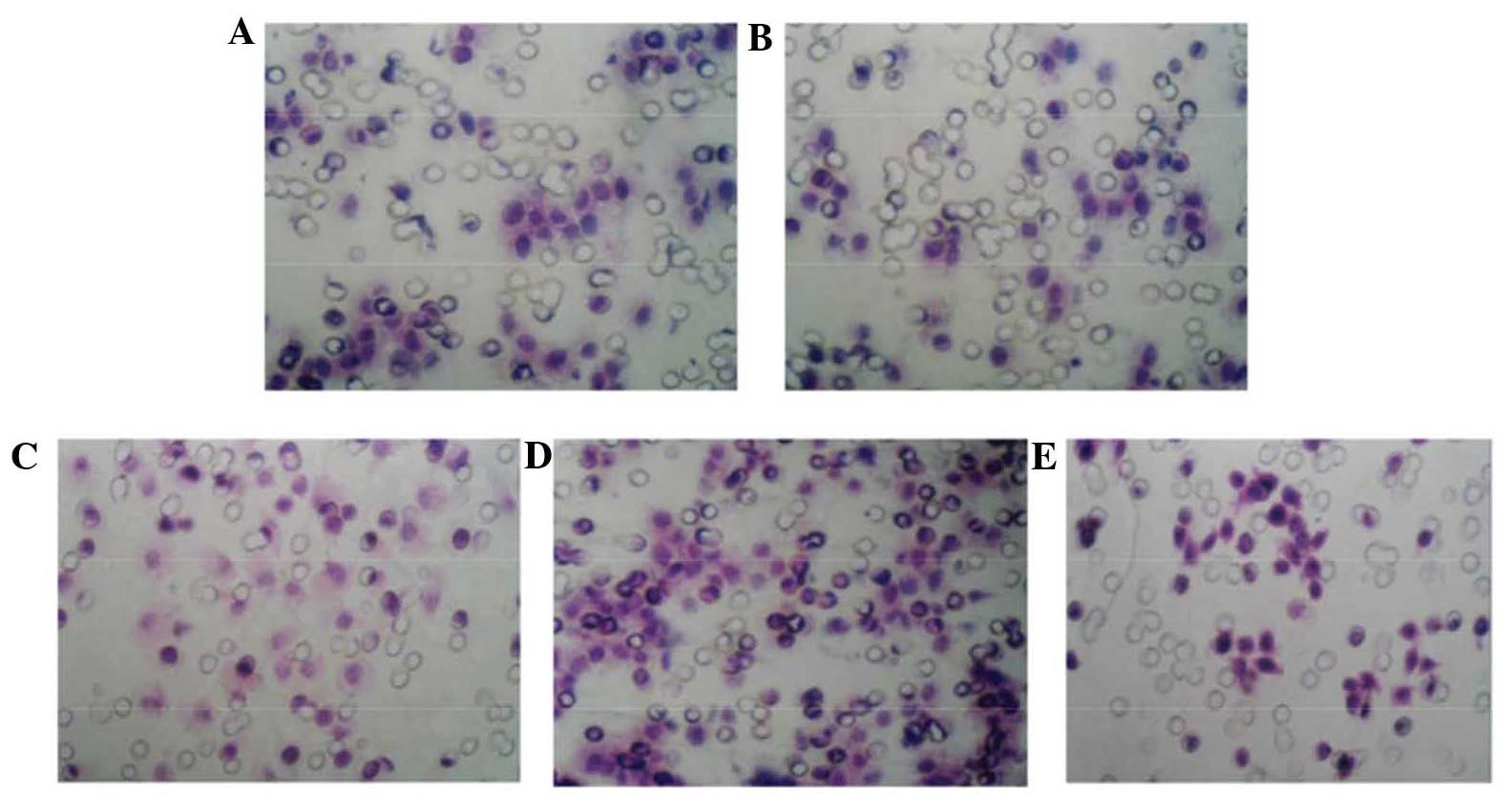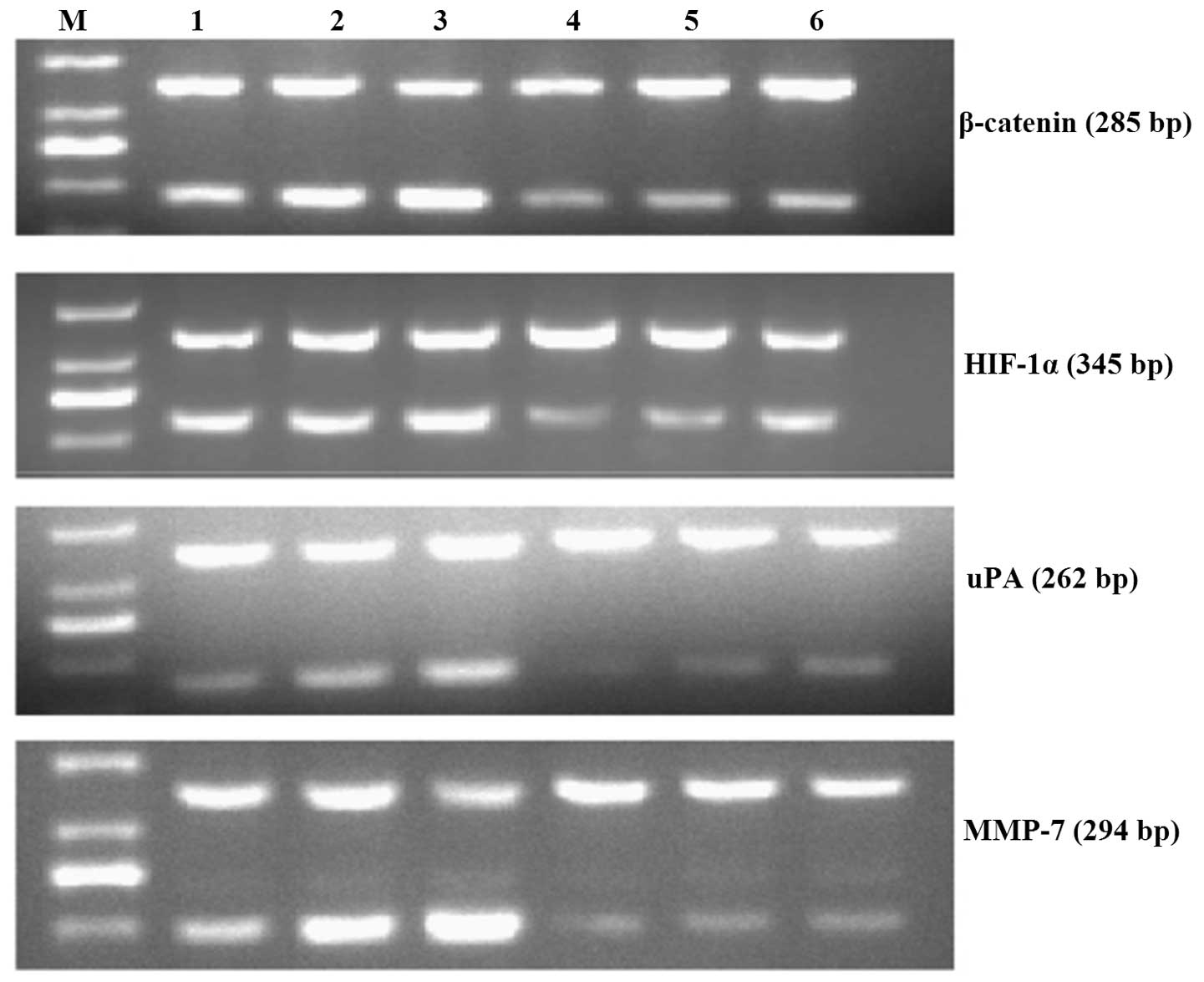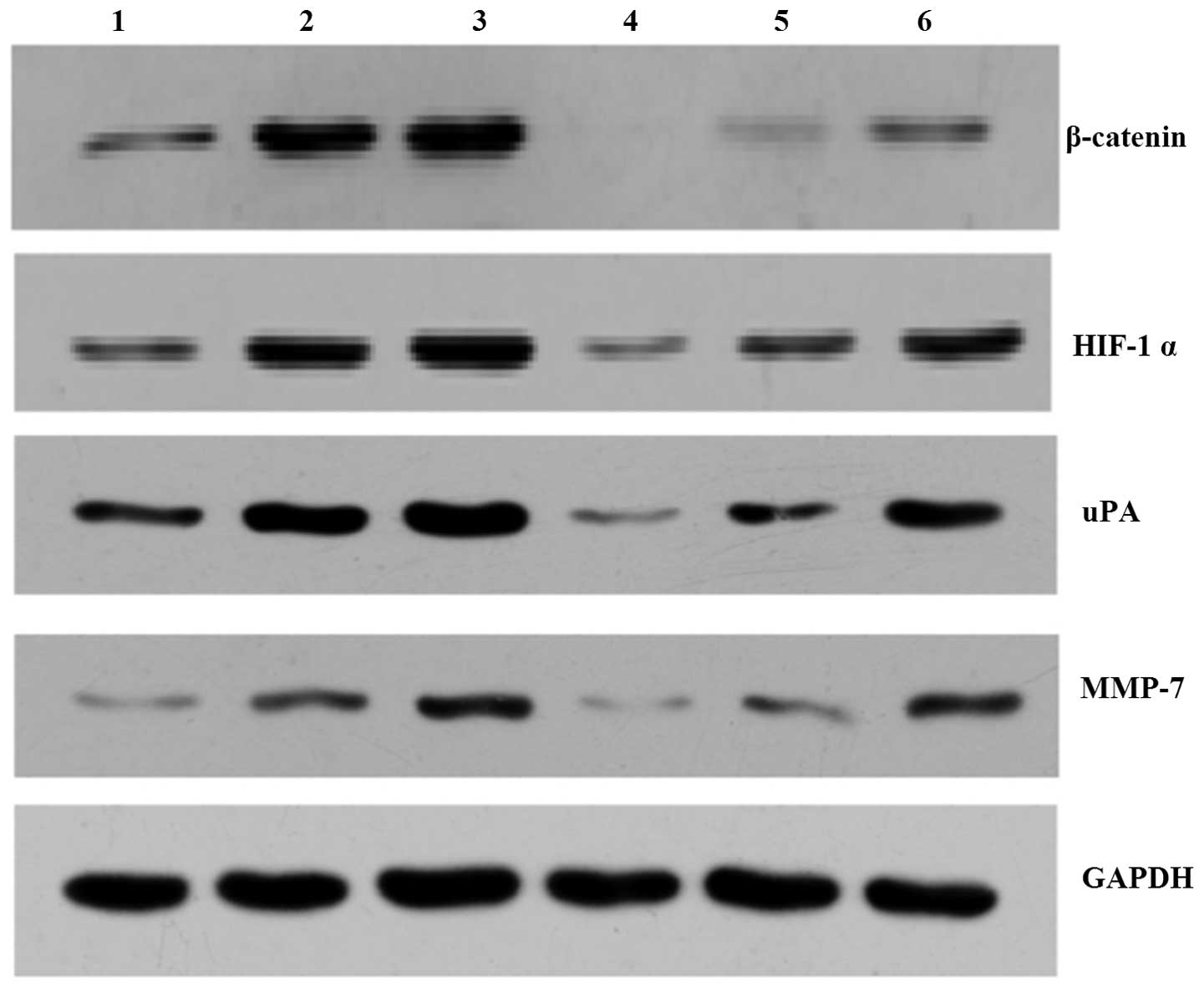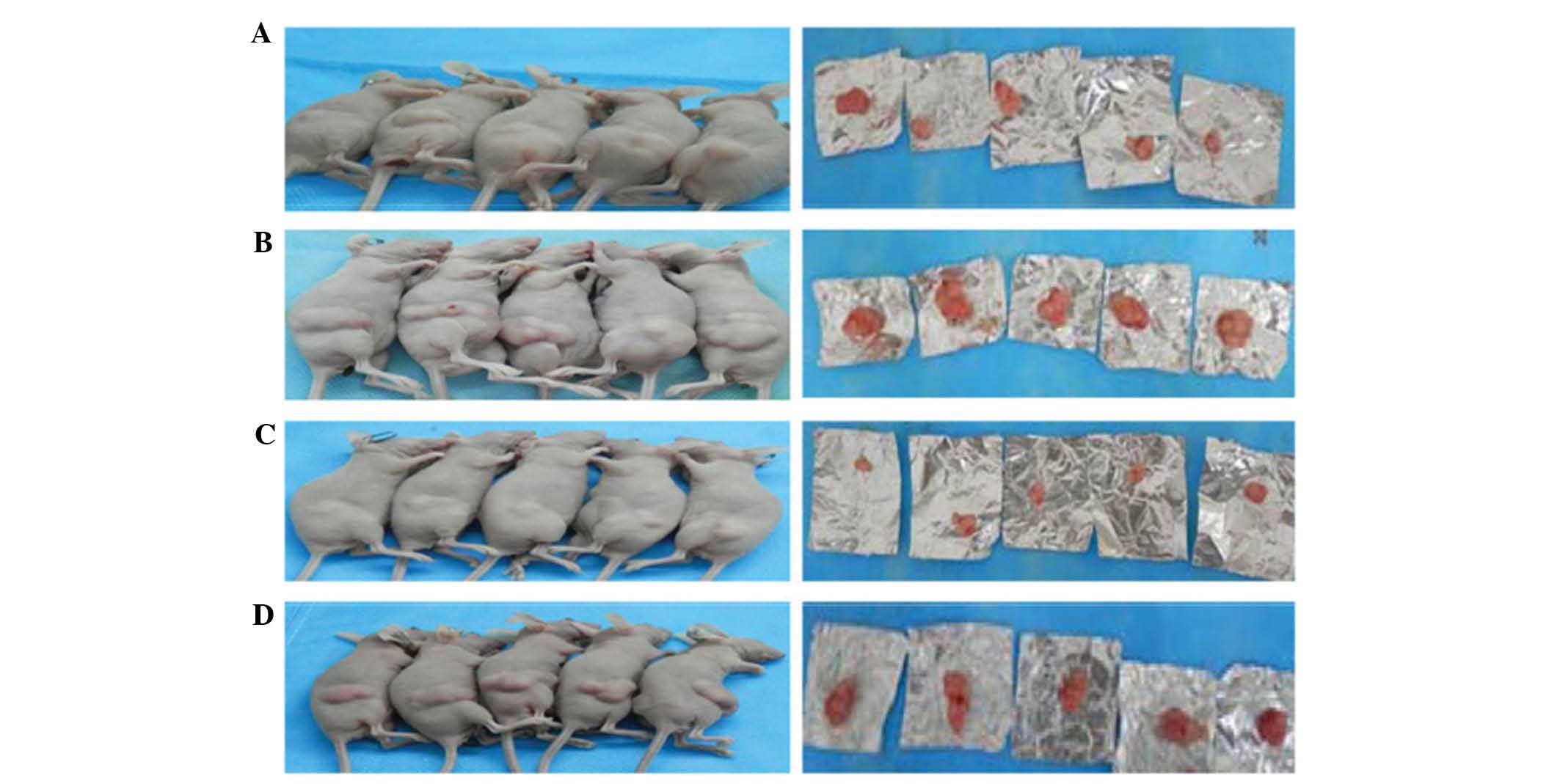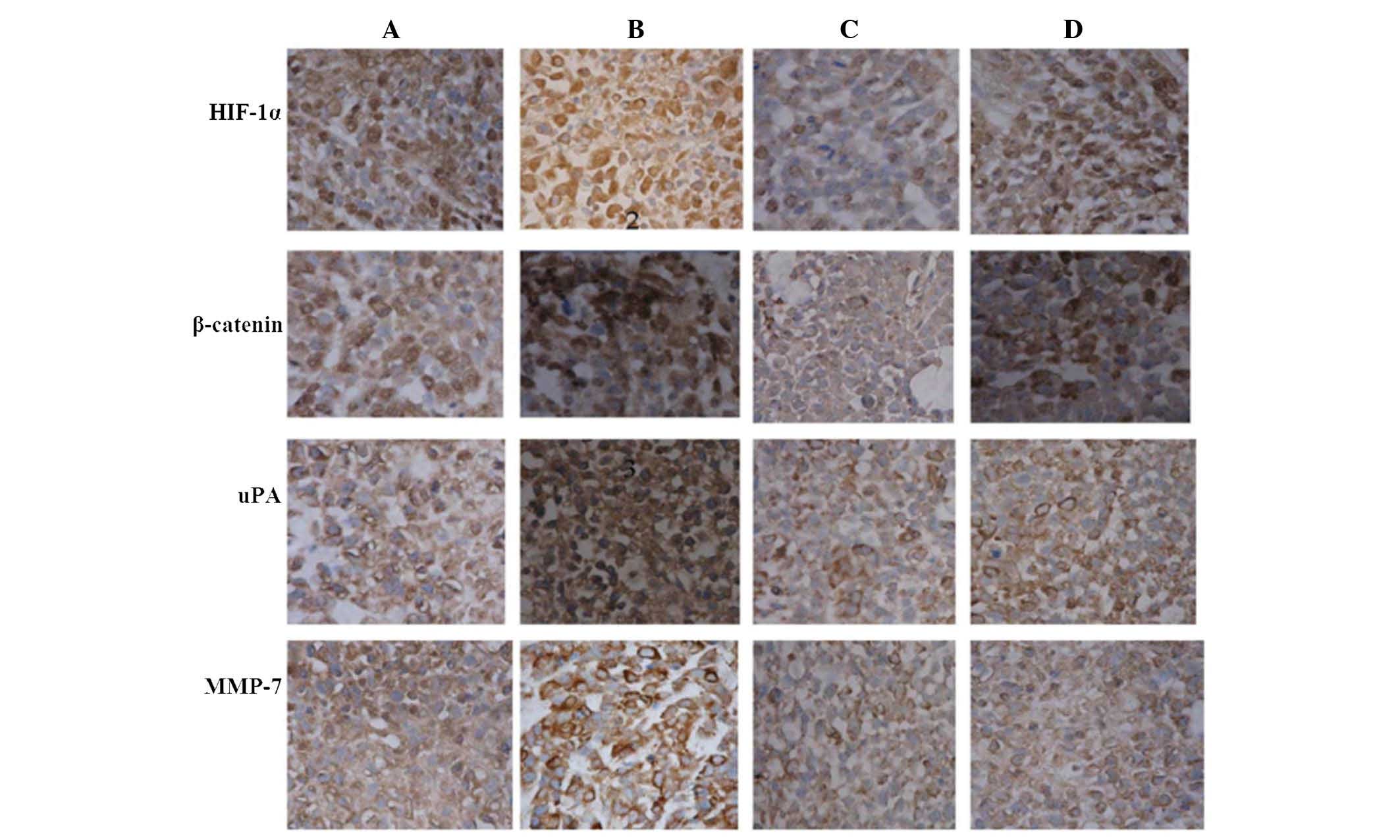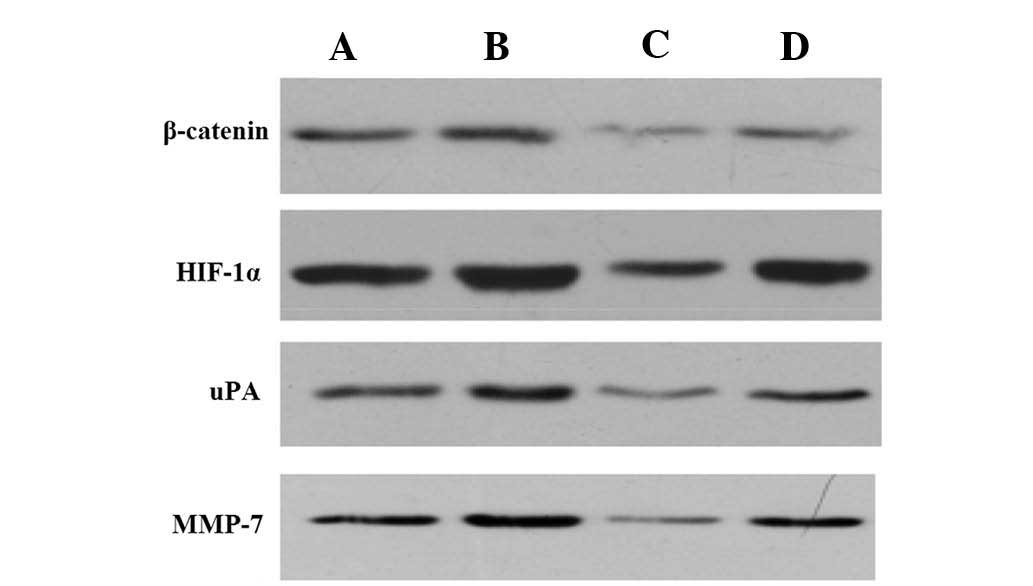Hypoxia-inducible factor-1α and Wnt/β-catenin signaling pathways promote the invasion of hypoxic gastric cancer cells
- Authors:
- Published online on: May 21, 2015 https://doi.org/10.3892/mmr.2015.3812
- Pages: 3365-3373
-
Copyright: © Liu et al. This is an open access article distributed under the terms of Creative Commons Attribution License [CC BY_NC 3.0].
Abstract
Introduction
The unlimited proliferation of tumor cells can cause hypoxia in tumor tissue. Hypoxia-inducible factor (HIF)-1α is an important transcription factor that regulates oxygen homeostasis, and may be associated with the occurrence of gastric cancer (1,2). HIF-1α is able to interact with specific signaling pathways that have important roles in adapting to hypoxia in tumor cells. In gastrointestinal tumors, the Wnt/β-catenin signaling pathway has been shown to affect cell proliferation, differentiation, and the regulation of microenvironment adaptability. HIF-1α competes with Tcf-4 for binding to β-catenin, and once bound it can activate HIF-1 target genes (3). Tumor cells generated in specific microenvironments have increased viability and can easily adapt to hypoxia (4) through activation of the canonical Wnt/β-catenin signaling pathway, which may lead to gastrointestinal tumorigenesis (5,6).
Invasion and metastasis involve numerous proteins from the matrix metalloproteinase (MMP) enzyme family (7,8). MMP-7 possesses strong matrix degradation activity, broad substrate specificity and has been shown to be overexpressed in invasive digestive cancers (9,10). In addition, the uroki-nase-type plasminogen activator (uPA) system can mediate cell-surface plasminogen activation, which can lead to degradation of the extracellular matrix and indirect activation of MMPs, which results in further degradation of extracellular matrix components (11). The expression of MMPs is associated with the micrometastasis of gastric cancer cells and poor prognosis, due to the important roles of these proteins in invasion and metastasis (12).
The present study examined the association between HIF-1α and Wnt/β-catenin in vitro in the SGC-7901 gastric cancer cell line. Furthermore, the signaling involved in metastasis and invasion was determined in vitro and in vivo under hypoxic conditions in SGC-7901 gastric cancer cells. The results of the present study may help to identify molecular targets for improved gastric cancer therapeutic strategies.
Materials and methods
Cell culture, plasmids and reagents
The SGC-7901 gastric cancer cell line was obtained from the Chongqing Medical University Key Laboratory of Neurology (Chongqing, China). The RNA interference (RNAi) sequences for pcDNA™6.2-GW/EmGFP-miR-β-catenin (5′-TGAACAAGACGTTGACTTGGA-3′) and the negative control pcDNA™6.2-GW/EmGFP-miR-β-catenin-n (5′-AAATGTACTGCGCGTGGAGAC-3′) were constructed by Invitrogen Life Technologies (Carlsbad, CA, USA). RPMI-l640 medium was purchased from HyClone Laboratories, Inc. (Logan, UT, USA). Fetal bovine serum (FBS) was purchased from Hangzhou Sijiqing Biological Engineering Materials Co., Ltd. (Hangzhou, China). Blasticidin was purchased from Sigma-Aldrich (St. Louis, MO, USA). Lipofectamine® 2000 was purchased from Invitrogen Life Technologies. RNAiso Plus, reverse transcription-polymerase chain reaction (RT-PCR) amplification, and reverse transcription kits were all purchased from Takara Biotechnology Co., Ltd. (Dalian, China).
Anti-HIF-1α (rabbit monoclonal antibody), anti-β-catenin (rabbit monoclonal antibody), anti-uPA (rabbit monoclonal antibody) and anti-MMP-7 (rabbit polyclonal antibody) were purchased from Epitomics (Burlingame, CA, USA)
Anti-GAPDH (rabbit monoclonal antibody), horseradish peroxidase (HRP)-conjugated goat anti-immunoglobulin G (IgG), radioimmunoprecipitation lysis buffer, phenylmethyl-sulfonyl fluoride, Bicinchoninic Acid (BCA) Protein Assay kit, Enhanced Chemiluminescence (ECL) reagent, goat anti-rabbit IgG and the immunohistochemistry streptavidin-peroxidase (SP) method chemical kit were purchased from Jiangsu BiYunTian Bio, Ltd. (Jiangsu, China).
Cell culture and transfection
SGC-7901 human gastric cancer cells were cultured under normoxic conditions in RPMI-1640 medium supplemented with 10% fetal bovine serum (FBS) at 37°C in an atmosphere containing 5% CO2 and 25% O2. SGC-7901 cells were cultured under hypoxic conditions in RPMI-1640 medium supplemented with 10% fetal bovine serum (FBS) at 37°C, in the presence of 5% CO2, 1% O2 and 94% N2 for 16 h. For double hypoxic conditions, SGC-7901 cells were cultured with 150 µmol/l CoCl2 (Sigma-Aldrich, St. Louis, MO, USA) (13) for 8 h concurrently with physical hypoxia for 16 h (2). All of the treatment and control groups were transfected with pcDNA™6.2-GW/EmGFP-miR-β-catenin or pcDNA™6.2-GW/EmGFP-miR-β-catenin-n in RPMI-1640 for 18 h at 37°C. A total of 1.6 µg/ml blasticidin was used for selection, and the cells were screened after 6-8 weeks in order to obtain the stably transfected cell line miR-β-catenin-7901.
Transwell invasion assays
The following five groups were included in the invasion assays: Control, liposome, negative control, hypoxia and hypoxia β-catenin knockdown. The cell migration and invasion assays of the cells were performed as described previously (14), using 8.0-µm pore polycarbonate membrane Transwell inserts in a 24-well plate. The control group was cultured under normoxic conditions. The liposome group was cultured under normoxic conditions with the addition of 10 µl liposome culture (Life Technologies, Carlsbad, CA, USA). The negative control group was cultured under normoxic conditions and transfected with the negative control plasmid pcDNA™6.2-GW/EmGFP-miR-β-catenin-n. The hypoxia group was cultured under physical hypoxic conditions. The hypoxia β-catenin knockdown group consisted of the stably transfected miR-β-catenin-7901 cell line cultured under physical hypoxic conditions.
To prepare the artificial basement membrane, Matrigel (40 µl; Life Technologies) was evenly spread on a Boyden chamber membrane (Life Technologies), and placed into 12-well plates. SGC-7901 cells (2×105) were seeded into the wells and cultured in RPMI-1640 supplemented with 5% FBS. The control, liposome and negative control groups were cultured for 24 h under normoxic conditions, whereas the hypoxic and hypoxic β-catenin knockdown groups were cultured for 8 h under normoxic conditions, and then cultured for 16 h under hypoxic conditions. The Boyden chamber was then removed, and the cells that remained on the upper surface were collected using a cotton swab. The cells remaining on the filter were fixed with 4% paraformaldehyde (Life Technologies) for 15 min, dried at room temperature, and stained with hematoxylin and eosin (Life Technologies). Images of the cells that had successfully migrated through the membrane were captured by microscopy (CKX41; Olympus, Tokyo, Japan) using a Canon camera (Canon, Japan). At least five different fields (magnification, ×200) were counted for each experiment, and the results of three independent experiments were averaged.
RT-PCR detection of HIF-1α, β-catenin, uPA and MMP-7 mRNA expression levels
SGC-7901 cells were divided into the following groups: Control (48 h normoxia), hypoxia (32 h normoxia, physical hypoxia 16 h), and double hypoxia (24 h normoxia, concurrent 8 h chemical hypoxia and 16 h physical hypoxia). In addition, miR-β-catenin-7901 cells were divided into the following groups: Control β-catenin knockdown group, hypoxia β-catenin knockdown group and double hypoxia β-catenin knockdown group, all of which were cultured under the same conditions as listed above. Total RNA was extracted from the cells using RNAiso Plus according to the manufacturer's instructions. Reverse transcription to generate cDNA and PCR amplification were performed using a 7300 Real-Time PCR system (Applied Biosystems, Life Technologies, Thermo Fisher Scientific, Waltham, MA, USA). The cycle parameters were set as follows: 94°C for 5 min, then 94°C for 30 sec, 56°C (internal reference, β-actin), 55°C (HIF-1α), 57°C (β-catenin), 56°C (uPA) and 57°C (MMP-7) for 35 sec, and 72°C extension for 1 min for 30 cycles; and a final extension at 72°C for 5 min. The primer sequences are shown in Table I. PCR products were separated by 2.5% agarose gel electrophoresis and quantified using Quantity One 4.62 software (Bio-Rad Laboratories, Inc., Hercules, CA, USA) to analyze the gray value of the PCR products.
Western blot analysis of HIF-1α, β-catenin, uPA and MMP-7 protein expression levels
Total protein was extracted from the six groups of cells, and the protein concentration was measured using the BCA method. Equal amounts of protein (50 µg) were separated by SDS-PAGE (Life Technologies) and transferred to polyvinylidene fluoride membranes. The membranes were primarily blocked with 5% skimmed milk and then incubated with the primary antibodies targeting HIF-1α (1:5,000; rabbit monoclonal), β-catenin (1:10,000; rabbit monoclonal), uPA (1:3,000; rabbit monoclonal), MMP-7 (1:10,000; rabbit monoclonal) and GAPDH (1:1,000; rabbit monoclonal). All antibodies were purchased from Epitomics (Burlingame, CA, USA). The membranes were then incubated with HRP-conjugated secondary antibodies and visualized using the ECL reagent. The film was scanned using a gel imager (Bio-Rad Laboratories, Inc.) and Quantity One 4.62 software was used to analyze the gray values of the protein bands.
Tumorigenicity assay and immunohistochemical staining in nude mice
BALB/c nude mice (n=5; 3 male, 2 female; 4–6 weeks old) were obtained from the Department of Laboratory Animal Science, Chongqing University Health Science Center (Chongqing, China). All animals were housed in standard conditions at 26–28°C, with 10 h light/14 h dull light and were given free access to food and water. All of the experiments were performed according to the animal protocol approved by the Institutional Animal Care and Use Committee of Chongqing Medical University (Chongqing, China). SGC-7901 cells were divided into the following groups: Control (48 h normoxia) and hypoxia (32 h normoxia, 16 h physical hypoxia). The miR-β-catenin-7901 cells were divided into a control β-catenin knockdown group and a hypoxia β-catenin knockdown group, which were cultured in the same manner as the SGC-7901 groups. The cells from each group were trypsinized, washed in phosphate-buffered saline (Life Technologies) and re-suspended in saline solution (Life Technologies). The nude mice were subcutaneously injected with 5×106 cells per 0.2 ml. Mice were divided into the control, hypoxia, interference and hypoxia interference groups, with five mice in each group. Tumor size was measured every third day. Tumor volume was calculated according to the following formula: V=(axb2)/2, where a was the largest superficial diameter and b the smallest superficial diameter. After four weeks, the mice were sacrificed by cervical dislocation, and the tumors were harvested and images were captured using a Canon IXUS 245 camera (Canon).
For the immunohistochemistry experiments, the tumors were harvested, fixed in formalin and embedded in paraffin (Life Technologies), and conventional immunohistochemistry sections were prepared. Detection was performed using the SP method in accordance with standard procedures (15). Positive expression was regarded as the presence of yellow-brown particles in cytoplasm or nucleus.
Western blot analysis of protein expression levels in tumor tissues
Fresh tumor tissue from each group was harvested, and total protein was extracted using a protein extraction kit, according to the manufacturer's instructions. Western blots were performed as described above. Blots were quantified using grey scale analysis.
Statistical analysis
Values are expressed as the mean ± standard error of the mean. The significance of differences between the groups was determined using Student's t-test and one-way analysis of variance. Appropriate post hoc tests were used when comparing multiple parameters. All analysis was performed using SPSS 17.0 software (IBM SPSS, Armonk, NY, USA). P<0.05 was considered to indicate a statistically significant difference.
Results
β-catenin knockdown decreases the invasiveness of gastric cancer cells under hypoxia
The invasion assay demonstrated that the number of invaded cells was not significantly different between the control, negative control and liposome groups. However, the number of invaded cells in the hypoxia group was increased as compared with that the control group, while the number in the hypoxia interference group was significantly decreased as compared with that in the hypoxia group (Table II and Fig. 1).
Effects of β-catenin knockdown and hypoxia on HIF-1α, β-catenin, uPA and MMP-7 mRNA and protein expression levels
RT-PCR and western blot analyses demonstrated that the mRNA and protein expression levels of β-catenin, HIF-1α, uPA and MMP-7 were low in the SGC-7901 control group, while they were significantly enhanced in the hypoxia group, and in the double hypoxia to an even greater extent (P<0.05) (Tables III and IV, Figs. 2 and 3). The control β-catenin knockdown (interference) group expressed significantly lower levels of β-catenin, HIF-1α, uPA and MMP-7 mRNA and protein as compared with those in the control group. In addition, the hypoxia β-catenin knockdown group expressed significantly lower levels of β-catenin, HIF-1α, uPA and MMP-7 mRNA and protein as compared with those in the hypoxia and control groups (P<0.05). The hypoxia β-catenin knockdown group expressed significantly lower levels of β-catenin, HIF-1α, uPA and MMP-7 mRNA and protein as compared with those in the double hypoxia interference group.
Table IIImRNA expression levels of HIF-1α, β-catenin, uPA and MMP-7 in each of the SGC-7901 gastric cancer cell groups. |
Table IVProtein expression levels of HIF-1α, β-catenin, uPA and MMP-7 protein in the SGC-7901 gastric cancer cell groups. |
The mRNA and protein expression levels of β-catenin, HIF-1a, uPA and MMP-7 were increased in the hypoxia β-catenin knockdown group and the double hypoxia β-catenin knockdown group, as compared with those in the control β-catenin knockdown group (P<0.05) (Tables III and IV, Figs. 2 and 3).
Compared to the double hypoxia β-catenin knockdown group to the hypoxia β-catenin knockdown group, uPA and MMP-7 mRNA and protein expression levels were significantly increased (P<0.05) (Table V).
Hypoxia accelerates growth of gastric xenograft tumors
Ten days following inoculation of the cells into nude mice, the cells from the hypoxia group began to form tumors. After 14 days, the cells from the control group also began to form tumors. Finally, after 16 days, the control and hypoxia β-catenin knockdown groups began to form tumors. Following inoculation, time-dependent increases in tumor volume were observed, which were accelerated after 22 days. According to the tumor volume and speed of growth, the tumorigenicity of the hypoxia group was higher as compared with that in the control group and the β-catenin knockdown group (Table VI, Fig. 4).
Immunohistochemical analysis of HIF-1α, β-catenin, uPA and MMP-7 expression in nude mouse xenografts
Four weeks after inoculation, the nude mice were sacrificed. The tumors were embedded in paraffin and immunohistochemistry detected HIF-1α, β-catenin and uPA expression predominantly in the nucleus, while MMP-7 expression was primarily located in the nucleus and the cytoplasm (Fig. 5). A lower protein expression levels was observed in the interference group compared with the control group.
Western blot analysis of protein expression levels in tumor tissue
HIF-1α, β-catenin, uPA and MMP-7 protein expression levels were highest in the tumor tissue from the hypoxia group and lowest in the interference group. Expression levels of these proteins were significantly reduced in the hypoxia interference group, as compared with those in the hypoxia group (P<0.05) (Fig. 6, Table VII).
Discussion
The carcinogenic activity of the Wnt/β-catenin pathway relies on the accumulation of cytosolic β-catenin. The Wnt signaling pathway is regulated by the levels of β-catenin in the cell; when the levels of β-catenin are elevated, the Wnt pathway is activated (16). HIF-1α stabilization depends on the phosphoinositide 3-kinase (PI3K)/Akt pathways, which are involved in the transcriptional activity of the extracellular signal-regulated kinase (ERK) pathway (17). The Wnt/β-catenin pathway communicates with the PI3K/Akt pathway (18), and β-catenin is also involved in activation of the ERK pathway (19). These observations suggested that increased HIF-1 expression and activity may be associated with the Wnt/β-catenin signaling pathway.
Following suppression of β-catenin expression using RNAi, β-catenin and HIF-1α expression levels were significantly reduced, indicating that HIF-1α levels dropped due to the decrease in β-catenin. These results are concordant with the findings of Kaidi et al (20) and Lee et al (21). The results of the present study suggested that HIF-1α may function downstream of Wnt/β-catenin and may be regulated by the Wnt/β-catenin signaling pathway. Conversely, in the double hypoxia and hypoxia groups, HIF-1α and β-catenin expression levels were increased as compared with those in the control group. Furthermore, following suppression of β-catenin expression, the levels of β-catenin did not remain constant in the stably transfected cell line. The hypoxia β-catenin knockdown group and the double hypoxia β-catenin knockdown group had increased expression levels of β-catenin, as compared with those in the control β-catenin knockdown group. It may therefore be hypothesized that hypoxia can stimulate an increase in HIF-1α, and that HIF-1α can activate β-catenin, stimulating the Wnt/β-catenin signaling pathway and activating downstream genes. Jiang et al (22) previously demonstrated, by western blot and RT-PCR analyses, that in prostate cancer cells, HIF-1α regulated the expression levels of β-catenin. Furthermore, Lim et al (23) suggested that HIF-1α may interact with hARD1 to regulate β-catenin.
A previous study by our group indicated that hypoxia is able to increase HIF-1α expression, which upregulates MMP-9 and uPA receptor expression in gastric cancer cells, resulting in increased adhesion, migration and invasion (2). In the present study, western blot and RT-PCR analyses demonstrated that in the hypoxia and double hypoxia groups, uPA and MMP-7 mRNA and protein expression levels gradually increased. Following knockdown of β-catenin expression, the hypoxia β-catenin knockdown group, as compared with the hypoxia group, as well as the double hypoxia β-catenin knockdown group, as compared with the double hypoxia group, had significantly decreased expression levels of uPA and MMP-7 mRNA and protein. Under hypoxic conditions and following treatment with cobalt chloride in order to increase the effectiveness of hypoxia, followed by β-catenin knockdown, the double hypoxia β-catenin knockdown group and the hypoxia β-catenin knockdown group had significantly elevated expression levels of uPA and MMP-7, as compared with those in the hypoxia β-catenin knockdown group and the β-catenin knockdown group. This suggested that suppression of β-catenin expression influenced MMP-7 and uPA expression levels, and under hypoxic conditions, HIF-1α was capable of regulating the expression of uPA and MMP-7, based on the magnitude of the enhanced hypoxia.
According to the in vitro invasion assay, the number of cells transgressing the membrane was increased in the hypoxia group, and invasion of the gastric cancer cells under hypoxic conditions was enhanced. Following knockdown of β-catenin expression, invasiveness was reduced under hypoxia. These results indicated that the absence of oxygen in the environment promotes the expression of HIF-1α, which increases β-catenin expression and activate the Wnt/β-catenin signaling pathway in gastric cancer cells, resulting in increased invasiveness.
In the nude mouse xenograft experiment, tumors from the hypoxia group were significantly larger as compared with those from the control group and the hypoxia β-catenin knockdown group, indicating that tumor growth was enhanced for the hypoxia group, as compared with that in the control group. The immunohistochemistry and western blotting results demonstrated that in the xenograft tumors from the hypoxia group, HIF-1α, β-catenin, uPA and MMP-7 protein expression levels were higher as compared with those in the control group and the hypoxia β-catenin knockdown group.
In conclusion, the in vitro transwell invasion assay capacity of gastric cancer cells is enhanced under hypoxic conditions when HIF-1α expression is increased by activating the Wnt/β-catenin signaling pathway, subsequently inducing the expression of uPA and MMP-7, which act on the extracellular matrix, promoting cell invasion and the development of gastric cancer.
In the present study, RT-PCR and western blot analyses demonstrated that a regulatory interaction exists between the Wnt/β-catenin pathway and HIF-1α. Concurrently, inhibiting β-catenin expression under hypoxic conditions reduced the size of the xenograft tumor as well as uPA and MMP-7 protein expression levels. These results suggested that the ability to enhance gastric cancer cell invasion under hypoxic conditions may be due to an increase in HIF-1α expression, which is real-ized through the activation of Wnt/β-catenin signaling, which can promote uPA and MMP-7 expression. uPA and MMP-7 may then degrade the extracellular matrix in order to promote tumor invasion, thereby contributing to gastric cancer invasiveness.
The present study suggested that in gastric cancer cells, HIF-1α has a role both upstream and downstream of the Wnt/β-catenin signaling pathway, and that these pathways have a reciprocal regulative function. Under hypoxic conditions, HIF-1α can facilitate the increased expression of uPA (24) and MMP-7 (25–27) through the Wnt/β-catenin pathway, which can promote the invasiveness of gastric cancer cells. These results may provide a basis for gastric cancer treatment at the molecular level.
References
|
Zhong H, De Marzo AM, Laughner E, et al: Overexprcssion of hypoxia-inducible factor 1alpha in common human cancers and their metastases. Cancer Res. 59:5830–5835. 1999.In Chinese. PubMed/NCBI | |
|
Deng T and Zhag JW: Relationship of hypoxia-inducible factor-1α and invasion of gastric cancer cells in hypoxia. Chin J Biologicals. 23:696–699. 2010. | |
|
Kolligs FT, Bommer G and Göke B: Wnt/beta-catenin/tcf signaling: A critical pathway in gastrointestinal tumorigenesis. Digestion. 66:131–144. 2002. View Article : Google Scholar : PubMed/NCBI | |
|
Dou J: Tumor stem cells. Southeast University Press; pp. 56–57. 2009 | |
|
Singh T and Katiyar SK: Honokiol inhibits non-small cell lung cancer cell migration by targeting PGE2-mediated activation of β-catenin signaling. PLoS One. 8:e607492013. View Article : Google Scholar | |
|
Panza A, Pazienza V, Ripoli M, et al: Interplay between SOX9, β-catenin and PPARγ activation in colorectal cancer. Biochim Biophys Acta. 1833:1853–1865. 2013. View Article : Google Scholar : PubMed/NCBI | |
|
Zhao XL, Sun T, Che N, et al: Promotion of hepatocellular carcinoma metastasis through matrix metalloproteinase activation by epithelial-mesenchymal transition regulator Twist1. J Cell Mol Med. 15:691–700. 2011. View Article : Google Scholar | |
|
Gialeli C, Theocharis AD and Karamanos NK: Roles of matrix metalloproteinases in cancer progression and their pharmacological targeting. FEBS J. 278:16–27. 2011. View Article : Google Scholar | |
|
Zhao H, Yang Z, Wang X, et al: Triptolide inhibits ovarian cancer cell invasion by repression of matrix metalloproteinase 7 and 19 and upregulation of E-cadherin. Exp Mol Med. 30:633–641. 2012. View Article : Google Scholar | |
|
Zhang JL, Chen GW, Liu YC, et al: Secreted protein acidic and rich in cysteine (SPARC) suppresses angiogenesis by down-regulating the expression of VEGF and MMP-7 in gastric cancer. PLos One. 7:e446182012. View Article : Google Scholar : PubMed/NCBI | |
|
Sroka IC, Sandoval CP, Chopra H, et al: Macrophage-dependent cleavage of the laminin receptor α6β1 in prostate cancer. Mol Cancer Res. 9:1319–1328. 2011. View Article : Google Scholar : PubMed/NCBI | |
|
Ding Y, Zhang H, Zhong M, et al: Clinical significance of the uPA system in gastric cancer with peritoneal metastasis. Eur J Med Res. 18:282013. View Article : Google Scholar : PubMed/NCBI | |
|
Yuan Y, Hilliard G, Ferguson T and Millhorn DE: Cobalt inhibits the interaction between hypoxia-inducible factor-alpha and von Hippel-Lindau protein by direct binding to hypoxia-inducible factor-alpha. J Biol Chem. 278:15911–15916. 2003. View Article : Google Scholar : PubMed/NCBI | |
|
Lee JW, Bae SH, Jeong JW, et al: Hypoxia-inducible factor (HIF-1) alpha: Its protein stability and biological function. Exp Mol Med. 36:1–12. 2004. View Article : Google Scholar : PubMed/NCBI | |
|
Fukumasu H, Cordeiro YG, Rochetti AL, Barra CN, Sámora TS, Strefezzi RF and Dagli ML: Expression of NR1I3 in mouse lung tumors induced by the tobacco-specific nitrosamine 4-(methylnitrosamino)-4-(3-pyridyl)-1-butanone. Braz J Med Biol Res. 48:240–244. 2015. View Article : Google Scholar : PubMed/NCBI | |
|
Miller JR, Hocking AM, Brown JD and Moon RT: Mechanism and function of signal transduction by the Wnt/beta-catenin and Wnt/Ca2+ pathways. Oncogene. 18:7860–7872. 1999. View Article : Google Scholar | |
|
Minet E, Michel G, Mottet D, et al: Transduction pathways involved in Hypoxia-Inducible Factor-1 phosphorylation and activation. Free Radic Biol Med. 31:847–855. 2001. View Article : Google Scholar : PubMed/NCBI | |
|
Lau MT, Klausen C and Leung PC: E-cadherin inhibits tumor cell growth by suppressing PI3K/Akt signaling via β-catenin-Egr1-mediated PTEN expression. Oncogene. 30:2753–2766. 2011. View Article : Google Scholar : PubMed/NCBI | |
|
Ji H, Wang J, Nika H, et al: EGF-induced ERK activation promotes CK2-mediated disassociation of alpha-Catenin from beta-Catenin and transactivation of beta-Catenin. Mol Cell. 36:547–559. 2009. View Article : Google Scholar : PubMed/NCBI | |
|
Kaidi A, Williams AC and Paraskeva C: Interaction between beta-catenin and HIF-1 promotes cellular adaptation to hypoxia. Nat Cell Biol. 9:210–217. 2007. View Article : Google Scholar : PubMed/NCBI | |
|
Lee SH, Kim MH and Han HJ: Arachidonic acid potentiates hypoxia-induced VEGF expression in mouse embryonic stem cells: involvement of Notch, Wnt and HIF-1alpha. Am J Physiol CellPhysiol. 297:C207–C216. 2009. View Article : Google Scholar | |
|
Jiang YG, Luo Y, He DL, et al: Role of Wnt/beta-catenin signaling pathway in epithelial-mesenchymal transition of human prostate cancer induced by hypoxia-inducible factor-lalpha. Int J Urol. 14:1034–1039. 2007. View Article : Google Scholar : PubMed/NCBI | |
|
Lim JH, Chun YS and Park JW: Hypoxia-inducible factor-1alpha obstructs a Wnt signaling pathway by inhibiting the hARD1-mediated activation of beta-catenin. Cancer Res. 68:5177–5184. 2008. View Article : Google Scholar : PubMed/NCBI | |
|
Moreau M, Mourah S and Dosquet C: β-Catenin and NF-κB cooperate to regulate the uPA/uPAR system in cancer cells. Int J Cancer. 128:1280–1292. 2011. View Article : Google Scholar | |
|
Brabletz T, Jung A, Dag S, et al: beta-catenin regulates the expression of the matrix metalloproteinase-7 in human colorectal cancer. Am J Pathol. 155:1033–1038. 1999. View Article : Google Scholar : PubMed/NCBI | |
|
Crawford HC, Fingleton B, Gustavson MD, et al: The PEA3 subfamily of Ets transcription factors synergizes with beta-catenin-LEF-1 to activate matrilysin transcription in intestinal tumors. Mol Cell Biol. 21:1370–1383. 2001. View Article : Google Scholar : PubMed/NCBI | |
|
Kang YJ, Park HJ, Chung HJ, et al: Wnt/β-catenin signaling mediates the antitumor activity of magnolol in colorectal cancer cells. Mol Pharmacol. 82:168–177. 2012. View Article : Google Scholar : PubMed/NCBI |



